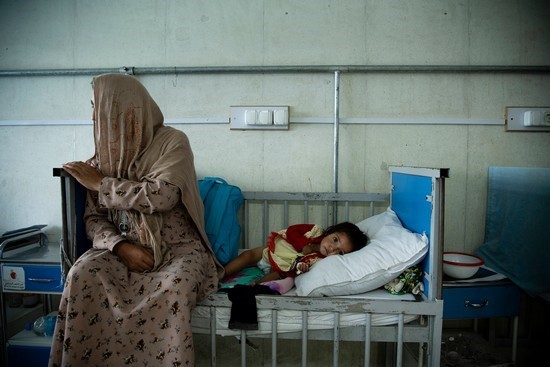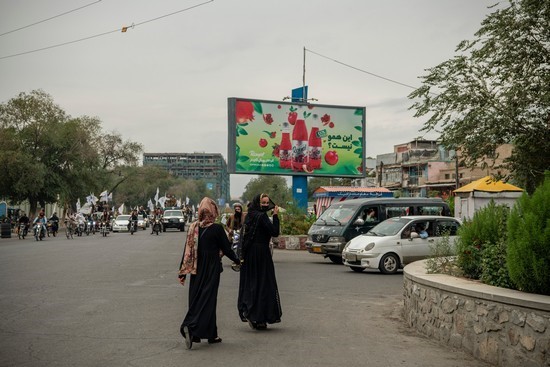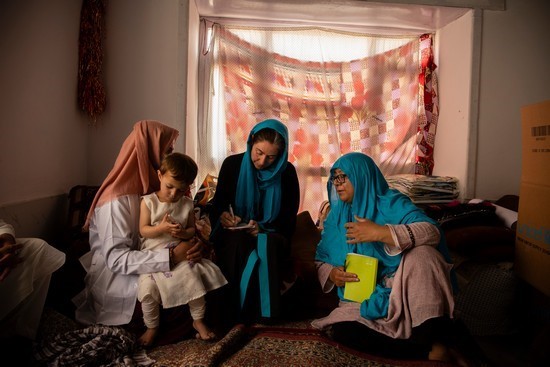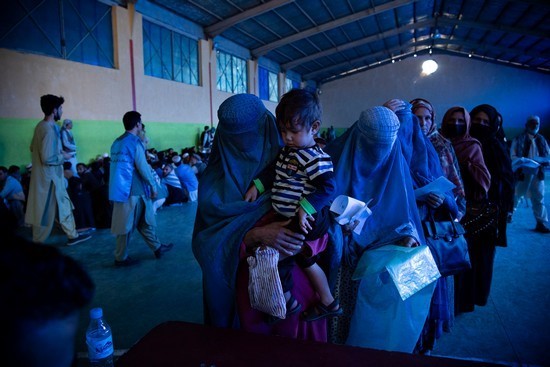For years before the Taliban seized power and the
economy collapsed, Jamila and her four children had clung to the edge of
survival. After her husband died trying to cross the Iranian border, she and
her children moved to a camp for displaced people in northwestern Afghanistan
and relied on aid organizations.
اضافة اعلان
One group brought her oil, flour, and rice — food that kept her
family from starving. Another gave her children pens and notebooks — the only
supplies they had in primary school. A third vaccinated them against measles, polio,
and other illnesses.
But when Jamila tried to arrange an emergency parcel of food in
late December, the aid worker cut the call short, explaining that the
organization had suspended its operations: Last month, the
Afghan government barred women from working in most local and international aid groups, prompting
many to stop their work. Jamila’s heart sank.
 Fatima, 15 months,
and her mother at Indira Gandhi Hospital’s overwhelmed malnutrition ward in
Kabul, Afghanistan, June 18, 2022.
Fatima, 15 months,
and her mother at Indira Gandhi Hospital’s overwhelmed malnutrition ward in
Kabul, Afghanistan, June 18, 2022.
“If they are not allowed, we will die of hunger,” said Jamila,
27, who goes by only one name, like many women in rural Afghanistan. “We are
starving.”
Just weeks since the Taliban administration’s decree, women
across the country are grappling with the disappearance of lifesaving aid that
their families and the country have relied on since the country plunged into a
humanitarian crisis.
It has been a dual tragedy for Afghanistan, and for
Afghan women in particular.
For many women and girls who had already faced increasing
restrictions under the new government — including being shut away from many
jobs, high schools, universities, and public parks — the new edict removed one
of the few remaining outlets for employment and public life. Given the
conservative system that had existed in
Afghanistan even before the Taliban
took power in 2021 and amplified the most hard-line traditions, aid groups had
relied on female workers to reach other women and their families, who were
often segregated from any contact with outside men.
“This is not a choice. This is not a political decision. It’s actually reality. We cannot do our job if we do not have a female staff in place to work.”
Now, amid a malnutrition and health care crisis that has
worsened as the Afghan government’s changes have turned the world away, many aid
groups say the banning of those female workers has made it nearly impossible
for them to work in the country. Those organizations described the move as a
“red line” that violated humanitarian principles and that, if it remains in
place, could permanently shut down their operations in Afghanistan.
The result is likely to be millions of Afghans left without
critical aid during the harsh winter months. A record two-thirds of the
population — or 28.3 million Afghans — are expected to need some form of
humanitarian assistance this year as a hunger crisis looms over the country,
according to United Nations estimates.
 Women cross a street
in front of Taliban fighters celebrating the first anniversary of the Taliban
takeover of Kabul on August 15, 2022.
Women cross a street
in front of Taliban fighters celebrating the first anniversary of the Taliban
takeover of Kabul on August 15, 2022.
“This is not a choice. This is not a political decision. It’s
actually reality. We cannot do our job if we do not have a female staff in
place to work,” Adam Combs, regional director at the Norwegian Refugee Council,
said in a news conference late last month.
In recent weeks, UN officials have met several times with Afghan
authorities to try to resolve the crisis, they said. But while
Afghan officials have urged the resumption of aid programs, they have also indicated that the
Taliban administration’s top leadership is unwilling to reverse the edict.
Instead, the leadership has doubled down on accusations that female aid workers
had not worn Islamic headscarves, or hijabs, in accordance with the new
government’s laws on women’s attire, according to summaries of those meetings
and other documents obtained by The New York Times.
“I don’t know the extent to which the Taliban understood the role of women in aid organizations and the crises that women will face after this.”
In a meeting in late December between UN officials and officials
with the Taliban administration in Kandahar — the heartland of the Taliban
movement and center of power of the new government — Afghan officials accused
Western countries, particularly the US, of using aid as political leverage to push
unwelcome Western values on the country, according to the documents.
Late last month, Zabihullah Mujahid, a spokesperson for the
Taliban administration, said on Twitter that all organizations within
Afghanistan must comply with the country’s laws, adding, “We do not allow
anyone to talk rubbish or make threats regarding the decisions of our leaders
under the title of humanitarian aid.”
 UNICEF staff members interview a woman about her health and
her child’s health at a mobile clinic in the village of Alisha, in Wardak
Province, Afghanistan, on June 11, 2022.
UNICEF staff members interview a woman about her health and
her child’s health at a mobile clinic in the village of Alisha, in Wardak
Province, Afghanistan, on June 11, 2022.
Afghan officials have said that the ban does not directly apply
to the U.N. — one of the last Western entities to maintain a
presence in Afghanistan. Still, most U.N. aid agencies work with nongovernment
organizations to implement their operations — many of which had relied on
female aid workers to reach women and families in need and have now suspended
their programs.
Many international donors also require that women make up at
least half of the people an aid organization reaches in order to receive
funding.
For women across the country, the effects of the ban and the
suspension of aid have been devastating.
The situation “is a disaster,” said Abeda Mosavi, an employee of
the Norwegian Refugee Council who works with Afghan widows in Kunduz, an
economic hub in northern Afghanistan. “I don’t know the extent to which the
Taliban understood the role of women in aid organizations and the crises that
women will face after this.”
 Nurses treat a measles patient in the intensive care ward
of a hospital in Herat, Afghanistan, March 6, 2022.
Nurses treat a measles patient in the intensive care ward
of a hospital in Herat, Afghanistan, March 6, 2022.
Since the ban was issued and the council suspended its
operations, Mosavi has barely been able to sleep, she said, haunted by worries
about the women she worked with to help make ends meet. Late last year, Mosavi
met a widow with eight children who she said was trying to secure a quick
marriage for her 13-year-old daughter — effectively selling her for a $2,000
dowry — to an older man to be his second wife. The woman felt it was the only
way she could keep her other children alive and fed, but Mosavi persuaded her
not to go through with it and put her in touch with a food aid program.
“I don’t know what will happen to her now,” Mosavi said, wracked
with worry. “There are hundreds of cases like this.”
Other female aid workers — many of whom are the sole providers
for their families — have themselves worried about how to put food on the table
if the ban remains in place.
“If we are not allowed to work in
NGOs, what should my children
and I eat?” said Najima Rahmani, 42. Rahmani, a widow in the northern province
of Balkh, was unemployed for six months before finding a job in November with
Coordination of Humanitarian Assistance, an implementing partner that works
with the UN’s World Food Program.
“My wound is always fresh. The wound of a woman in my situation is always fresh. It never heals.”
Those six months without a job were like a living nightmare, she
said.
Her family could not afford electricity in their home. She had
to borrow money from relatives — who were struggling themselves — to try to
scrape together the university fees for her two sons and daughter.
The government’s barring of women from attending universities
last month was devastating to her and her daughter. Then the ban on NGO work
came down, and it felt not just like a new blow, but like a prison sentence,
condemning them all to return to a life of begging and hardship.
“I am in a lot of pain,” Rahmani said, breaking down in tears.
“My wound is always fresh. The wound of a woman in my situation is always
fresh. It never heals.”
Since the fall of the Western-backed government in August 2021, the
new authorities’ initial promises that women would have opportunities like
employment and a public life — requirements for engagement with Western donors
— have nearly all been reversed.
 Women wait to
register for food aid from the World Food Program in Kabul, Afghanistan, June
16, 2022.
Women wait to
register for food aid from the World Food Program in Kabul, Afghanistan, June
16, 2022.
Today, women are barred from gyms and public parks and from
traveling any significant distance without a male relative. They cannot attend
high school or university. At checkpoints along streets and in spot inspections
on farms, the morality police chastise women who are not covered from head to
toe in all-concealing burqas and headpieces in public.
It has been a realization of some women’s worst fears about
Taliban rule and a devastating loss for those who had hoped for much more than
just an end to the war.
Habiba Akbari, who works for
Afghan Aid, a British humanitarian
and development organization, spent much of the past four years dodging
sporadic fighting between the Western-backed government and Taliban forces to
travel between her hometown in Badakhshan province and her university in Kunduz
City.
Akbari graduated last year — just before the Taliban
administration banned women from attending university — and secured a job with
the aid group. Her monthly salary of 30,000 Afghanis (around $350) sustained
her seven siblings and parents after her oldest sister and the family’s main
provider was dismissed from her post as a prosecutor. But now her work has been
suspended — and any hope she held for her future has vanished.
“The Taliban are burying us alive,” Akbari said.
Read more Lifestyle
Jordan News











